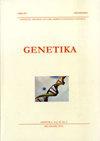Genetic characterization of pepper (Capsicum annuum L.) genotypes from central Anatolia with SSR and SCAR markers
4区 农林科学
Q3 Agricultural and Biological Sciences
引用次数: 1
Abstract
The major objective in pepper breeding programs is to generate high yielding novel varieties resistant to pests and diseases, tolerant to abiotic stress conditions with improved fruit quality traits including capsaicin content. Germplasm collections are important sources of variability for breeding studies. Molecular markers are important tools to evaluate genetic relationships among germplasm collections. Moreover, markers are used to select the genotypes conferring the desired traits via marker-assisted selection (MAS) as a powerful approach accelerating breeding programs. In the current study, 56 pepper genotypes selected among 313 pepper genotypes collected from K?r?ehir province in the Central Anatolian region of Turkey according to their agronomic and morphological characteristics were used for molecular assays. Six SSR markers two of which were linked to fruit morphology were selected to characterize pepper genotypes according to their high polymorphism information content. Three SCAR markers associated with capsaicinoid synthesis and resistance to Phytophtora capsici (Phyto.5.2) in pepper were used to assess pungency and resistance among genotypes. According to the results obtained with SSR markers, the total number of alleles ranged from 1 to 8 among genotypes. The most polymorphic SSR markers were CaeMS015 and CAMS452 within the pepper population. The genetic distance among genotypes was determined ranging between 0.75-1.00. The segregation of the SCAR marker BF6-BF8 linked to pungency in pepper was determined relative to pungent and sweet reference cultivars. The OP004.717 SCAR marker linked to Phytophtora capsici was tested among genotypes relative to CM334 pepper variety, known as a source of resistance to Phytophtora.中南安纳托利亚辣椒(Capsicum annuum L.)基因型的SSR和SCAR标记遗传分析
辣椒育种计划的主要目标是培育高产新品种,抗病虫害,耐非生物胁迫条件,改善果实品质性状,包括辣椒素含量。种质资源是育种研究中变异的重要来源。分子标记是评价种质资源间亲缘关系的重要工具。此外,标记被用来通过标记辅助选择(MAS)作为加速育种计划的有力方法来选择赋予所需性状的基因型。本研究从云南辣椒品种收集到的313种辣椒基因型中筛选出56种辣椒基因型。土耳其中部安纳托利亚地区的ehir省根据其农艺和形态特征进行了分子分析。选用6个SSR标记,其中2个与果实形态相关,多态性信息含量高,可用于辣椒基因型鉴定。利用3个与辣椒素合成和对辣椒病抗性相关的SCAR标记,对不同基因型辣椒的辛辣性和抗性进行了评价。SSR标记结果显示,各基因型的等位基因总数在1 ~ 8个之间。辣椒群体中多态性最高的SSR标记是CaeMS015和CAMS452。基因型间的遗传距离在0.75 ~ 1.00之间。对辣椒中与辣味相关的SCAR标记BF6-BF8与辣味和甜味参比品种的分离性进行了测定。在辣椒品种CM334的相关基因型中检测了辣椒疫霉(Phytophtora capsici)相关的OP004.717 SCAR标记。
本文章由计算机程序翻译,如有差异,请以英文原文为准。
求助全文
约1分钟内获得全文
求助全文
来源期刊

Genetika-Belgrade
AGRONOMY-GENETICS & HEREDITY
CiteScore
1.80
自引率
0.00%
发文量
1
审稿时长
6-12 weeks
期刊介绍:
The GENETIKA is dedicated to genetic studies of all organisms including genetics of microorganisms, plant genetics, animal genetics, human genetics, molecular genetics, genomics, functional genomics, plant and animal breeding, population and evolutionary genetics, mutagenesis and genotoxicology and biotechnology.
 求助内容:
求助内容: 应助结果提醒方式:
应助结果提醒方式:


